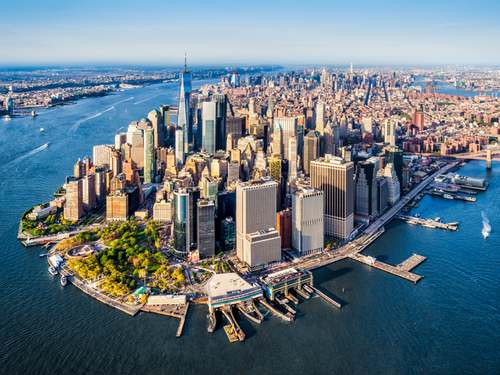NY Passes Low-Carbon Concrete Bill
WEDNESDAY, JUNE 16, 2021
The New York legislature recently passed a bill that is designed to promote the use of low-carbon concrete for state construction projects. The bill is now on its way to Gov. Andrew Cuomo’s desk.
Bill S542A requires the Office of General Services to establish guidelines concerning the procurement of low-carbon concrete for state projects. Contractors would need to follow these guidelines and certify that their materials meet guideline targets.
The bill also outlines that the office will need to examine when crafting said guidelines such as incentives—as a tax credit that was initially associated with the bill was removed in the final version that passed. (New Jersey, meanwhile, is looking at similar legislation that still includes a tax incentive.)
The office would then be awarding future contracts to companies based on these climate performances as well as price.

 |
| Eloi_Omella / Getty Images |
|
The New York legislature recently passed a bill that is designed to promote the use of low-carbon concrete for state construction projects. The bill is now on its way to Gov. Andrew Cuomo’s desk. |
Assuming Cuomo signs the bill, it will take effect 180 days after and would apply to any state contracting opportunities advertised o or after that date.
The Associated General Contractor of New York State formally opposed the bill in April, noting that while it applauds the overall goal, it argues that not enough testing has been done on low-embodied carbon concrete to know if it meets all standards.
“This bill poses significant safety, quality, environmental, procurement, liability, insurability, technological, feasibility, and constructability problems for public works projects in New York State,” the AGC statement reads.
“State agencies and authorities have rigorous standards for the specification and testing of materials prior to including a requirement in state procurements. This bill mandates low-embodied carbon concrete on public work before a thorough state analysis of specifications and testing for the feasibility and practicability for such a construction material. Additionally, without the proper state specifications and testing of low-embodied concrete, New York may jeopardize federal infrastructure funding.”
The state, however, maintains that the bill is a crucial step toward its net-zero emissions economy goal by 2050, which was passed in 2019.
Green New York
Cuomo and legislative leaders reached an agreement to pass Senate Bill S6599, which sets a net-zero emissions economy goal by 2050, in June 2019. The legislation was one of the United States' most aggressive climate change action plans to date.
First introduced in April that year, New York Mayor Bill de Blasio introduced the “New Green Deal,” a $14 billion plan that is aimed to reduce the city’s greenhouse emissions by 30% by 2030. The plan is outlined in the city’s report, “OneNYC 2050: Building a Strong and Fair City.”
Following numbers tracked from 2005, the plan describes several initiatives that will reduce emissions by certain percentages, helping to put the state on track for full carbon neutrality by 2050, according to the city’s press release.
By the end of the same month, the state approved the Climate Mobilization Act—a package of bills and resolutions intended for radical energy efficient improvements.
All bills require that 100% of new residential and commercial buildings’ roof areas are covered by one of the following green roof options: plants, solar panels and/or small wind turbines. Compared to other cities that only require 25-50% coverage, the city has also planned incentives to help cover the cost of installation.
The retrofitting of thousands of buildings statewide is estimated to cost $4 billion.
In a vote 41-21, the Climate Leadership and Community Protection Act was passed, requiring New York to reduce its emissions 85% below 1990 levels by 2050 and offset the remaining 15% by removing carbon dioxide from the atmosphere through planting trees, greening infrastructure and investing in proper technology.
Through the legislation, New York joined California, Colorado, Hawaii, Nevada, New Mexico and Washington as states with zero-emission electricity goals or requirements. However, New York goes a step further by targeting transportation and food sectors to achieve emission cuts.
In order to achieve the bill’s goal in steps, the legislation sets an initial goal for the state to produce 70% of its electricity from renewable sources such as hydropower, solar and wind by 2030. According to The New York Times, the state already produces about 60% of its electricity through carbon-free sources, mostly made up of nuclear power plants, hydroelectric dams and small amounts of wind and solar.
To accommodate the new target’s goal, the state also intends on building offshore wind turbines, enforcing its green roof and solar programs and installing new large batteries to juggle all the renewable power sources.
Making up a third of the state’s emissions, the transportation system—which includes approximately 10 million cars, trucks and busses—is expected to be one of the largest challenges.
According to City Lab, the new rules will create a demand for an estimate of more than 3,600 construction jobs per year and 4,400 jobs in maintenance, services and operations.
Moving forward, the implementation of the bill will be left to a 22-person “climate action council” consisting of top state officials, covering various topics and shall be advised by a smaller group experienced in everything from land use to forestry. The council will also be required to issue recommendations for how to meet the required goals in two years, after the state’s regulatory agencies issue rules to make industries and residents meet the bill’s standards.
Tagged categories: Carbon footprint; concrete; Environmental Controls; Government; Green Infrastructure; Laws and litigation



